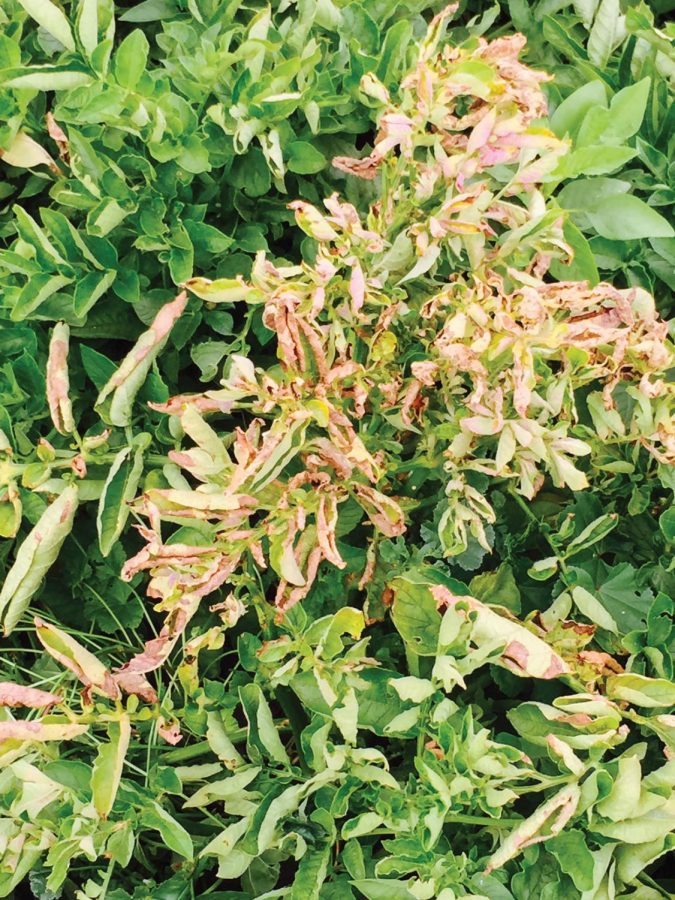Potato Rescue
November 17, 2015
Researchers at Oregon State University received a $2.7 million dollar grant which allows them, along with colleagues in Washington and Idaho, to begin battling potato disease currently impacting Pacific Northwest potato farmers.
In recent years, farmers have discovered a new insect-transmitted disease in potatoes called zebra chip. Zebra chip comes from the bacteria potato psyllid which infects the plants and causes black stripes to appear on the potato’s insides, rendering it unmarketable.
“We hadn’t seen this disease in the Pacific Northwest before 2011, when there was a widespread outbreak in Washington, Oregon and Idaho,” said department of crop and soil science professor Stuart Rietz.
Once the plant is infected there is no cure for it. According to Extension Entomologist Specialist Silvia Rondon, the unmarketability of zebra chip infected potatoes could potentially be very detrimental to not only Oregon, but also to the entire United States.
“The Pacific Northwest produces close to 55 percent of the potatoes in the United States, causing the zebra chip disease to have potentially devastating consequences,” Rondon said.
The grant provides the research team with funding to begin gathering information on the psyllid population.
“The early grant enables us to develop and implement an area-wide potato psyllid monitoring program in order to determine adult potato psyllid dynamics within northeastern Oregon commercial potato fields and integrate with the current area-wide aphid pest monitoring program,” said Extension Agronomist Darrin Walenta.
The research team will spend the first three years of the five year project collecting background data on sampling fields and determining the relationship between the psyllid population and environmental conditions to help determine where the bacteria will be.
“We have been focusing on environmental factors that would influence where the psyllids would be the most prevalent. They produce a large number of weeds and migrate into the potato fields,” Reitz said. “This allows us to begin determining which fields would be most likely to be potentially affected by the disease.”
Groups within the research team are working on determining different aspects of the psyllids, allowing them to use this information to forecast the movements of zebra chip.
“My lab specifically has been working on determining what the insect does in the winter,” Rondon said. “Determining what different populations do in different seasons can help us predict how the psyllid bacteria spreads.”
The research team is not only working from their labs, they are also teaming up with farmers all over the Pacific Northwest to help them become as well-equipped as possible to stop the spread of zebra chip.
“This grant is also directly targeted to providing tools for the growers to spot zebra chip infected fields,” Reitz said. “We have a close relationship with farmers and they decided this is one of their most prevalent pest problems, and are very interested in helping us to better target their management.”
One of the long-term goals of the research team is to eventually design a mobile app for smartphones and computers. This app will allow the user to enter in characteristics of their fields, such as location and environmental factors, and the app can tell you what risk for psyllid infection they will have for the upcoming season, as well as help decide what management plans the farmers should use.
“This app will not only be a quantitative way to look at risk, but also an easy tool that any farmer can use to make the best-informed decisions about how to raise their crops zebra chip free,” Reitz said.

















































































![Newspaper clipping from February 25, 1970 in the Daily Barometer showing an article written by Bob Allen, past Barometer Editor. This article was written to spotlight both the student body’s lack of participation with student government at the time in conjunction with their class representatives response. [It’s important to note ASOSU was not structured identically to today’s standards, likely having a president on behalf of each class work together as one entity as opposed to one president representing all classes.]](https://dailybaro.orangemedianetwork.com/wp-content/uploads/2025/03/Screenshot-2025-03-12-1.00.42-PM-e1741811160853.png)























